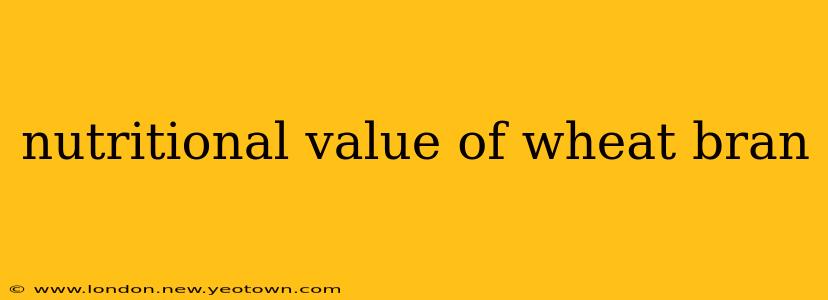Wheat bran. The name might conjure images of bland, slightly gritty cereal, but this humble byproduct of wheat milling is a nutritional powerhouse often overlooked. It's not just a fiber source; it's a complex blend of nutrients that play a vital role in maintaining good health. Let's dive into the fascinating world of wheat bran and uncover its hidden benefits.
My journey into the world of nutrition began with a simple question: why did my grandmother always insist on adding wheat bran to her morning oatmeal? Her answer, delivered with the wisdom of years, sparked my interest in this often-underappreciated ingredient. This article is the culmination of that initial curiosity, combined with years of research and a passion for healthy eating.
What is Wheat Bran and Where Does it Come From?
Wheat bran is the outer layer of the wheat kernel, the part that protects the grain. During the milling process that refines wheat into white flour, this outer layer is separated. While often discarded in the production of white bread and pastries, wheat bran retains a wealth of nutrients that are lost in the refining process. Think of it as nature's protective casing, packed with goodness.
What are the Nutritional Benefits of Wheat Bran?
Wheat bran is primarily known for its high fiber content, both soluble and insoluble. This dual fiber action is what makes it so beneficial for digestive health and beyond. But its nutritional profile extends far beyond just fiber.
Soluble Fiber: This type of fiber dissolves in water, forming a gel-like substance that helps regulate blood sugar levels and lower cholesterol.
Insoluble Fiber: This type of fiber adds bulk to the stool, promoting regular bowel movements and preventing constipation.
Beyond fiber, wheat bran is a good source of:
- Magnesium: Crucial for muscle function, blood sugar control, and blood pressure regulation.
- Manganese: Supports bone health, wound healing, and metabolism.
- Selenium: A powerful antioxidant that protects against cell damage.
- Vitamin B1 (Thiamine): Essential for energy production and nerve function.
- Vitamin B6 (Pyridoxine): Plays a role in brain development and immune function.
What are the Health Benefits of Consuming Wheat Bran?
The nutritional profile of wheat bran translates into a wide range of health benefits:
- Improved Digestive Health: The high fiber content promotes regular bowel movements and relieves constipation.
- Lowered Cholesterol: Soluble fiber helps lower LDL ("bad") cholesterol levels.
- Stabilized Blood Sugar: Fiber slows down the absorption of sugar, preventing blood sugar spikes.
- Weight Management: The high fiber content promotes satiety, helping you feel fuller for longer and potentially aiding in weight loss.
- Reduced Risk of Certain Diseases: Some studies suggest that regular consumption of wheat bran may reduce the risk of heart disease, type 2 diabetes, and certain types of cancer.
How Much Wheat Bran Should I Eat Daily?
The recommended daily intake of fiber varies depending on age and gender, but most adults should aim for 25-30 grams per day. Wheat bran can contribute a significant portion of this, but it's crucial to increase your fiber intake gradually to avoid digestive discomfort like bloating and gas. Start with a small amount (1-2 tablespoons) and gradually increase it over time.
How Can I Incorporate Wheat Bran into My Diet?
Wheat bran doesn't have to be a culinary chore. It can be seamlessly integrated into your diet in various ways:
- Add it to your cereal or yogurt: A simple and effective way to boost the nutritional value of your breakfast.
- Bake with it: Incorporate wheat bran into muffins, bread, or pancakes for added fiber and nutrients.
- Sprinkle it on your salads or soups: A sneaky way to add extra fiber to your meals.
Is There Anything I Should Be Aware Of When Consuming Wheat Bran?
While wheat bran offers numerous health benefits, it's important to be aware of a few potential drawbacks:
- Increased Gas and Bloating: Increasing fiber intake too quickly can lead to digestive discomfort. Start slowly and gradually increase your consumption.
- Potential for Nutrient Interactions: Wheat bran can bind to certain minerals, potentially reducing their absorption. Spacing out your wheat bran intake from mineral supplements can help mitigate this.
Can Wheat Bran Help With Weight Loss?
The high fiber content in wheat bran contributes to satiety, meaning it helps you feel fuller for longer. This can be helpful in managing weight, as it may reduce overall calorie intake. However, wheat bran alone isn't a magic weight-loss bullet. It should be part of a balanced diet and exercise plan for optimal results.
What are the Differences Between Wheat Bran, Oat Bran, and Rice Bran?
While all three are bran types, they differ slightly in their nutritional profiles. Wheat bran is generally higher in fiber than oat bran, while rice bran is a good source of antioxidants. The best choice for you will depend on your individual dietary needs and preferences.
In conclusion, wheat bran is far more than just a fiber source; it's a nutritional treasure trove that deserves a prominent place in your diet. By understanding its nutritional benefits and incorporating it wisely into your meals, you can take a significant step towards a healthier and more balanced lifestyle. Remember to consult with a healthcare professional or registered dietitian before making significant changes to your diet, especially if you have any underlying health conditions.

